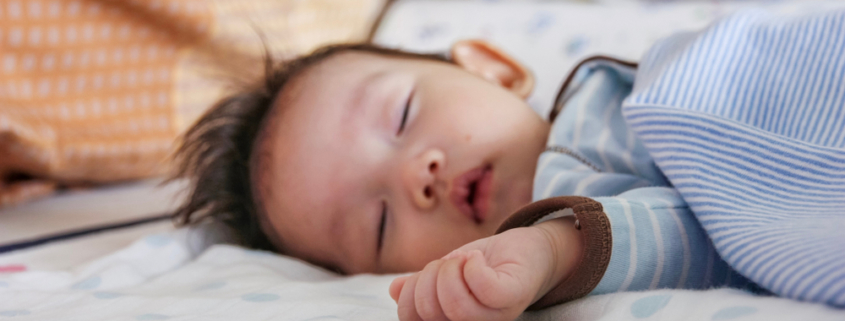What Does Sleep Apnea Look Like in a Child?
Is your child snoring heavily at night or have you heard that ADHD can be linked to childhood sleep apnea and you think your little one may be a candidate? Sleep apnea displays differently in children than it does in adults. Take a look at some of the symptoms that may indicate your child has sleep apnea.
Did you know that 1-4% of children may have sleep apnea, many of them between the ages of 2-8 years old?
American Sleep Apnea Association
Whereas obesity is the primary risk factor for sleep apnea in adults, for children, enlarged adenoids and tonsils are more likely to blame, although some children’s sleep apnea can be linked back to obesity. Other risk factors include down syndrome, abnormalities in the skull or face, cerebral palsy, sickle cell disease, neuromuscular disease, a history of a low birth weight, and a family history of obstructive sleep apnea, according to the Mayo Clinic. Dental issues can also be underlying conditions. To learn more, read Dr. Mandanas’ blog about dental signs of sleep apnea.
Nighttime Symptoms of Childhood Sleep Apnea
Your child doesn’t have to struggle with snoring to have sleep apnea; they may simply be experiencing extremely disturbed sleep. Nighttime symptoms include:
- Snoring
- Heavy Breathing
- Chronic Mouth Breathing
- Long Pauses in Breathing
- Snorting, Coughing, or Choking
- Sleeping in Odd Positions
- Restless Sleep (Tossing & Turning)
- Teeth Grinding
- Sweating
- Bed Wetting
- Sleep Walking
- Night Terrors
Daytime Symptoms Childhood Sleep Apnea
Adult, daytime sleep apnea symptoms typically revolve around fatigue, but childhood symptoms typically have to do with behavioral issues. Daytime symptoms include:
- Difficulty Waking Up
- Naps
- Mouth Breathing
- Nasal-ey Voice
- Behavioral Problems
- Hyperactivity
- Difficulty Paying Attention
- ADHD
- Irritability
- Cognitive Issues
- Headaches
- Learning Problems
- Poor Performance at School
- Social Issues
- Poor Weight Gain
- Stunted Growth
- Frequent Infections
Dental Treatments for Childhood Sleep Apnea
Many parents do not treat their child’s sleep apnea under the assumption that they will “grow out of it,” however, untreated sleep apnea has many short-term and long-term consequences for children.
Children need restful sleep for healthy cognitive and physical growth and development. When they are deprived of this, they can struggle with behavioral and health issues in their childhood and in their adult life.
One of the most common treatments for childhood sleep apnea is the CPAP machine, although some cases require surgery or medicine. Unfortunately, many children are “CPAP rejects,” which means they cannot tolerate the CPAP machine because it is uncomfortable and annoying. Dr. Mandanas and many other integrative dentists like her offer an effective alternative to CPAP.
For many children, Dr. Mandanas can provide a dental appliance that pushes their lower jaw forward to keep the tissue in the mouth from collapsing and blocking the airway when it relaxes at night. This appliance is far more comfortable than CPAP and Dr. Mandanas has found that her child patients have little trouble adhering to the treatment.
When your child sees Dr. Mandanas, she will assess whether or not a dental appliance may be right for them. She may combine this treatment with lifestyle and dietary changes if your child is overweight. For children who have overly enlarged tonsils and adenoids, she may refer your child to an ear, nose, and throat (ENT) specialist whom she recommends. If you are interested in scheduling an appointment with Dr. Mandanas for your child’s sleep apnea, give us a call!



